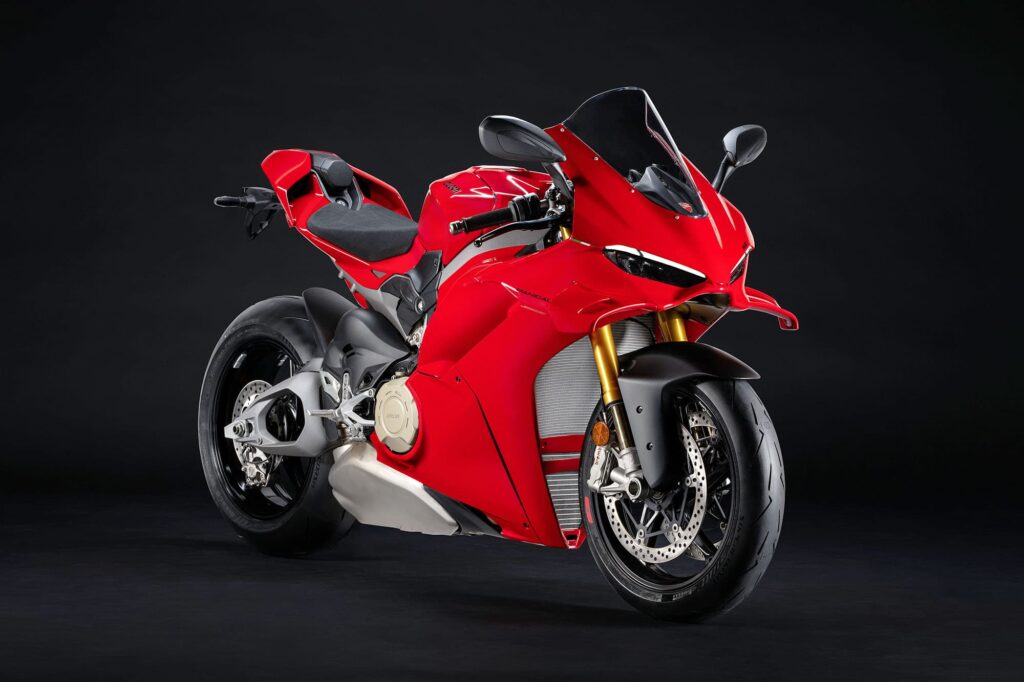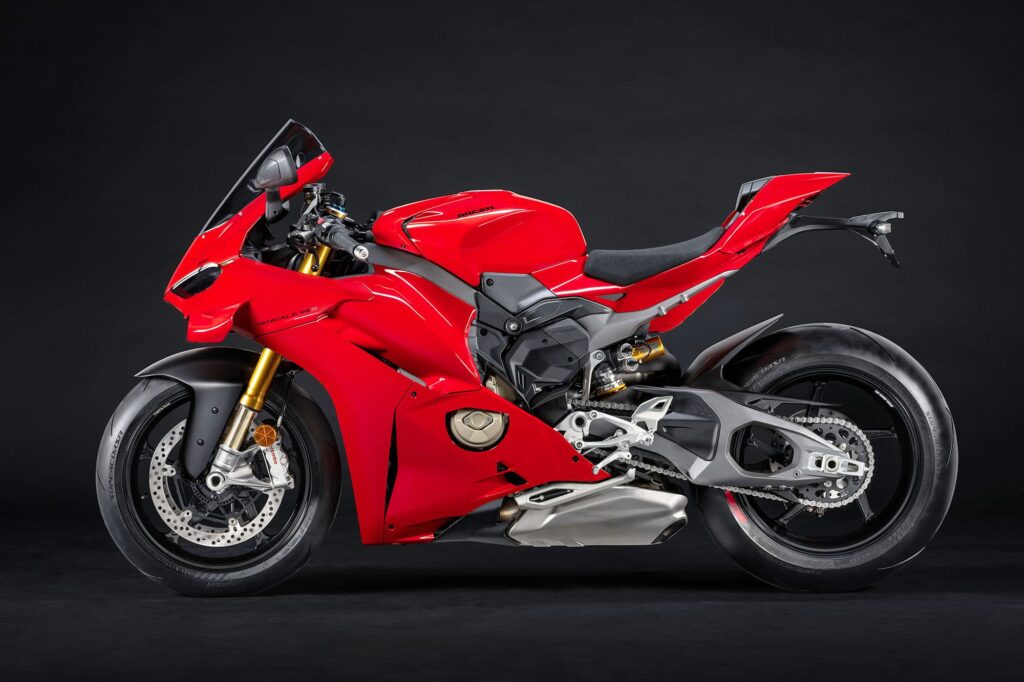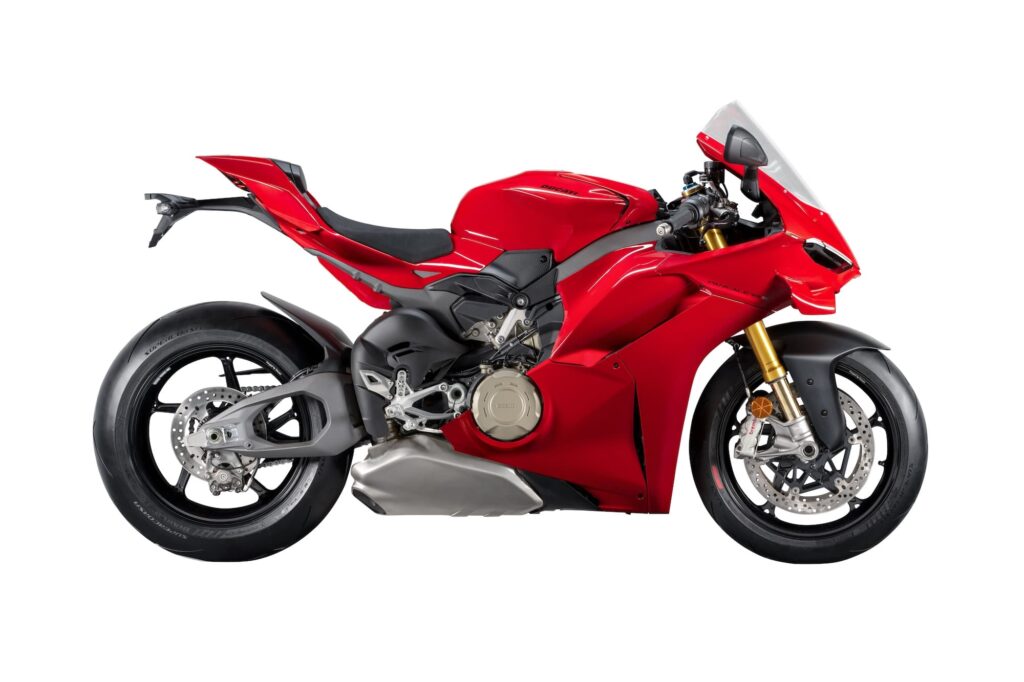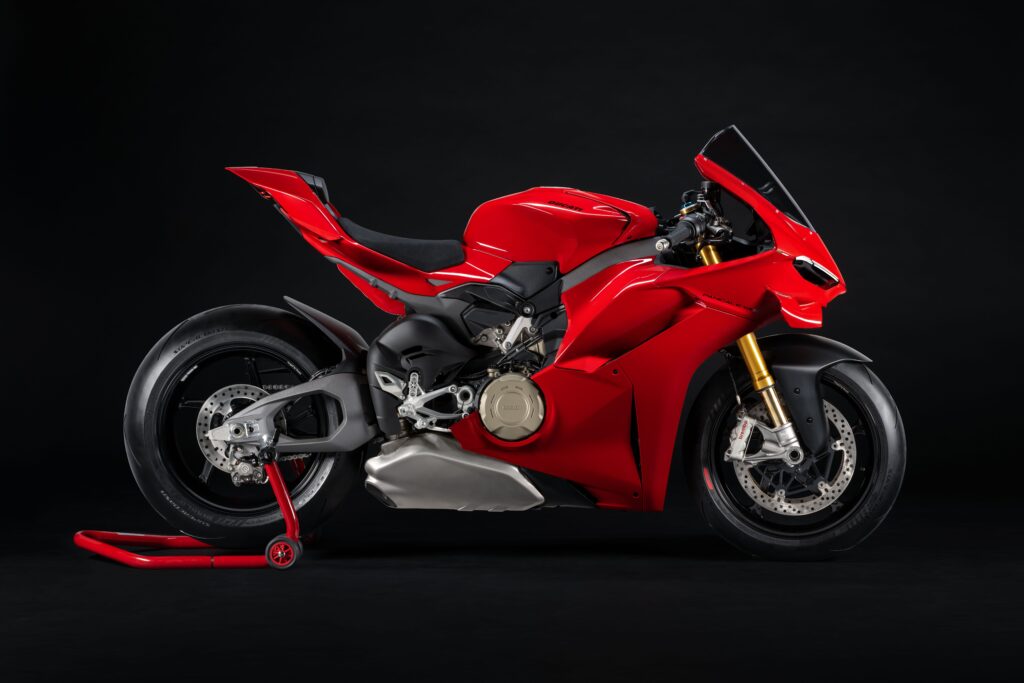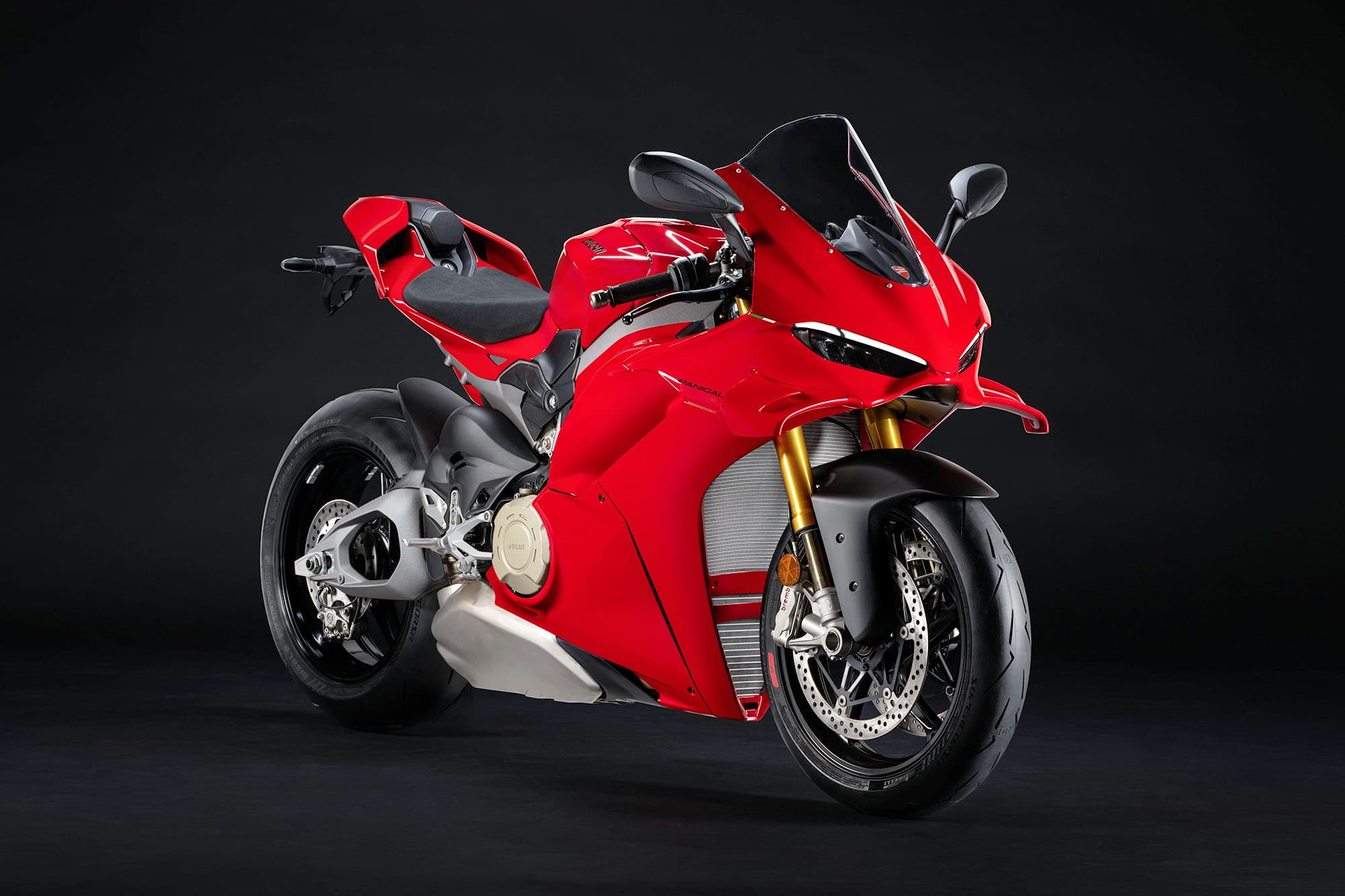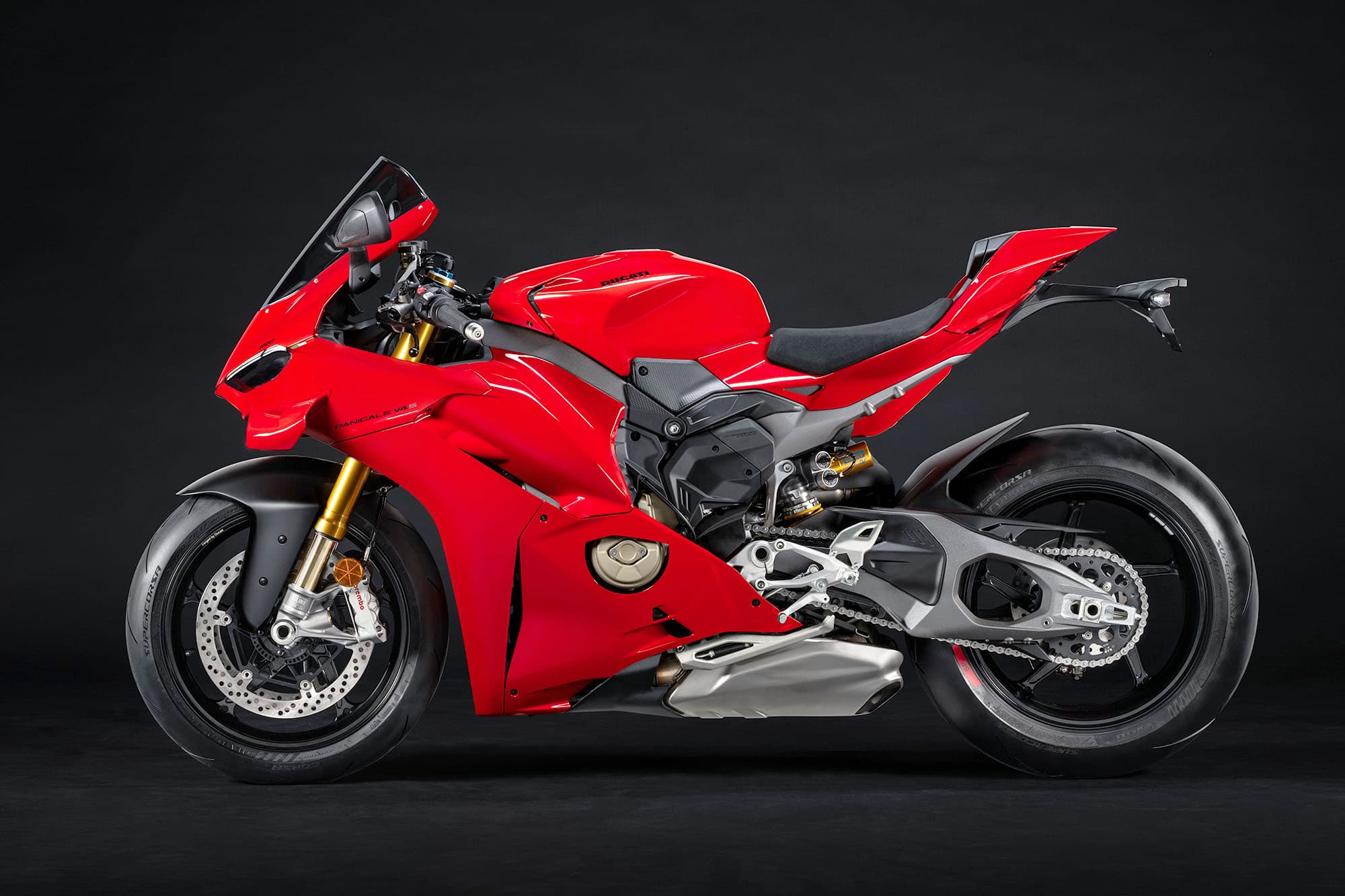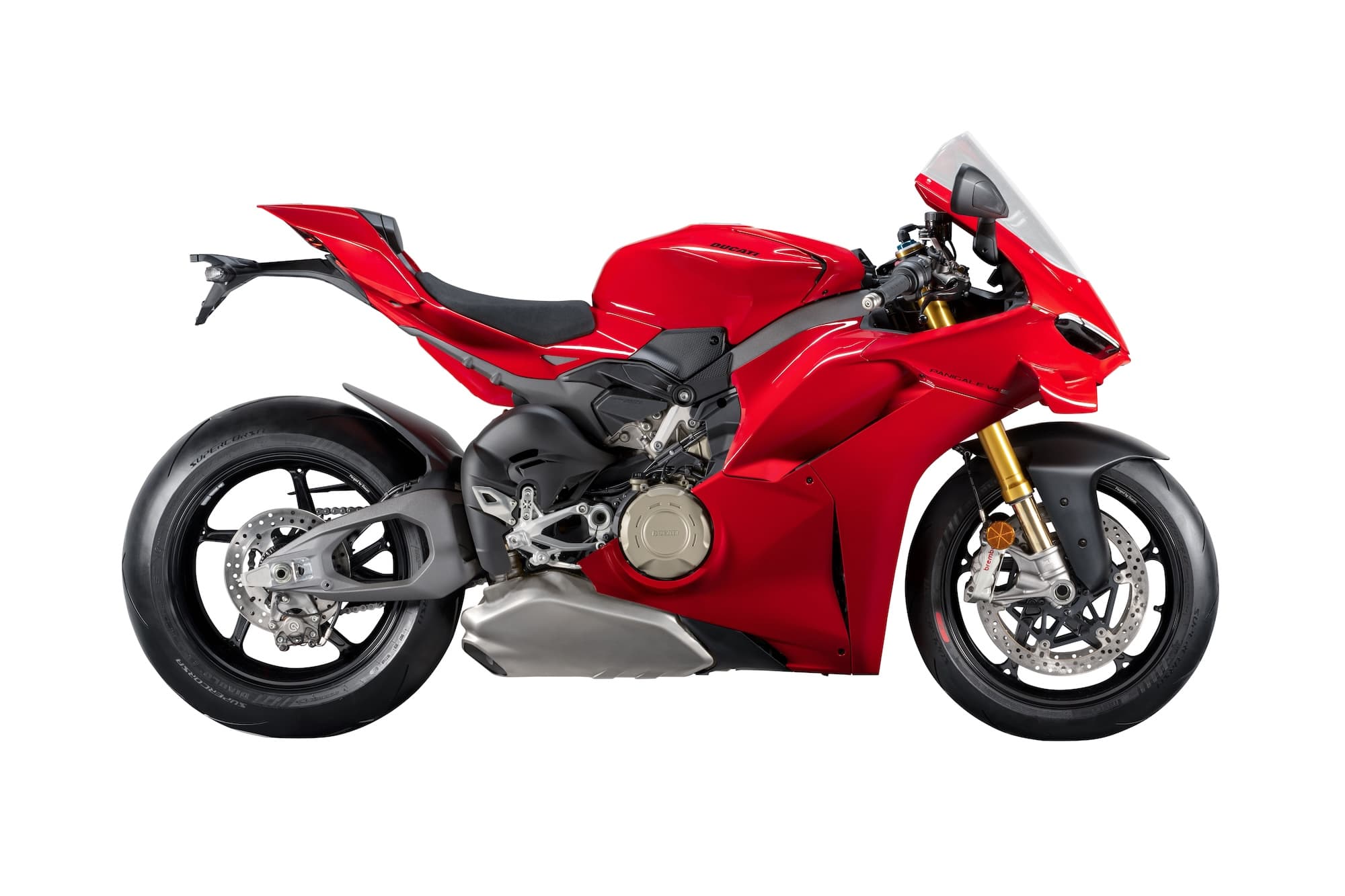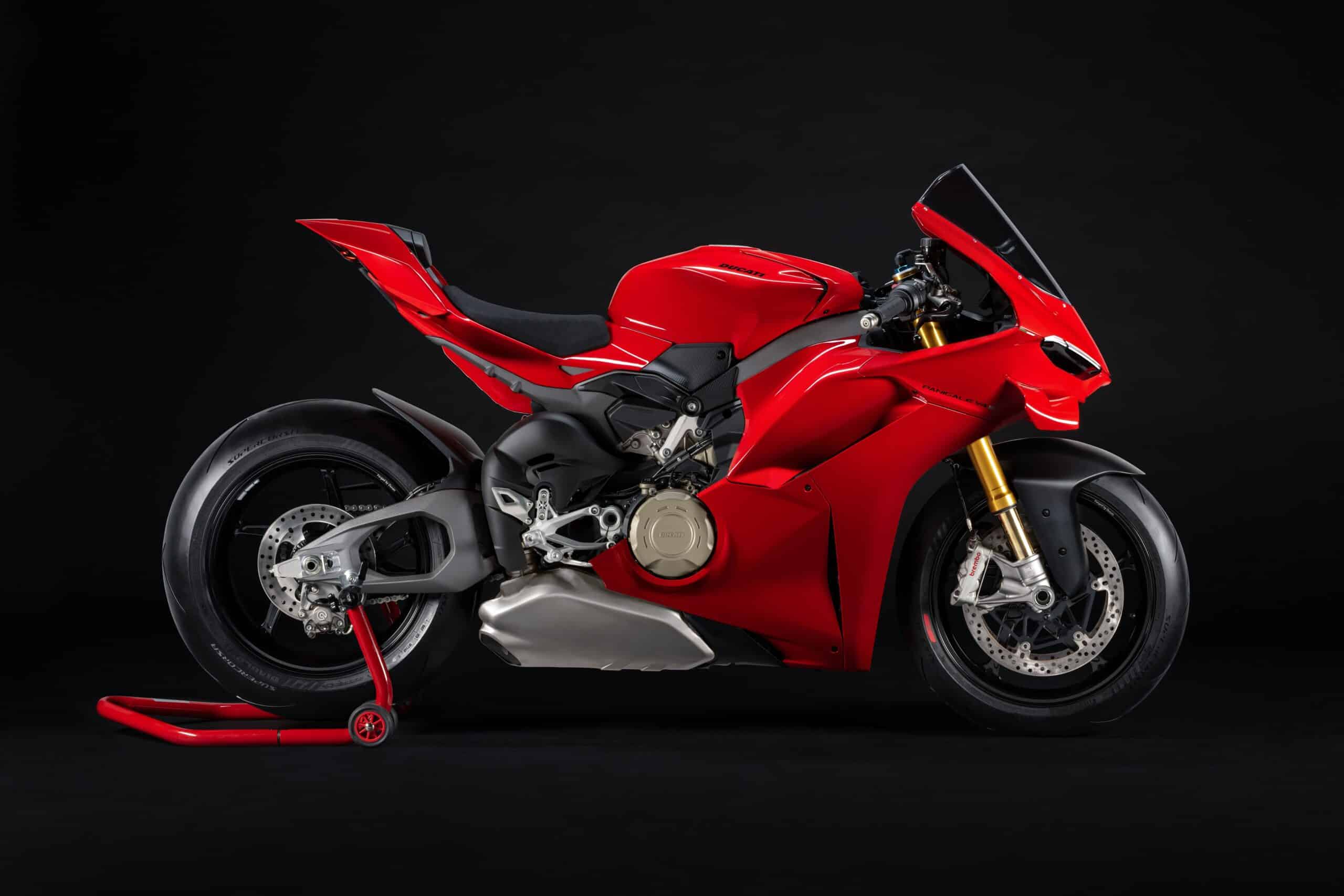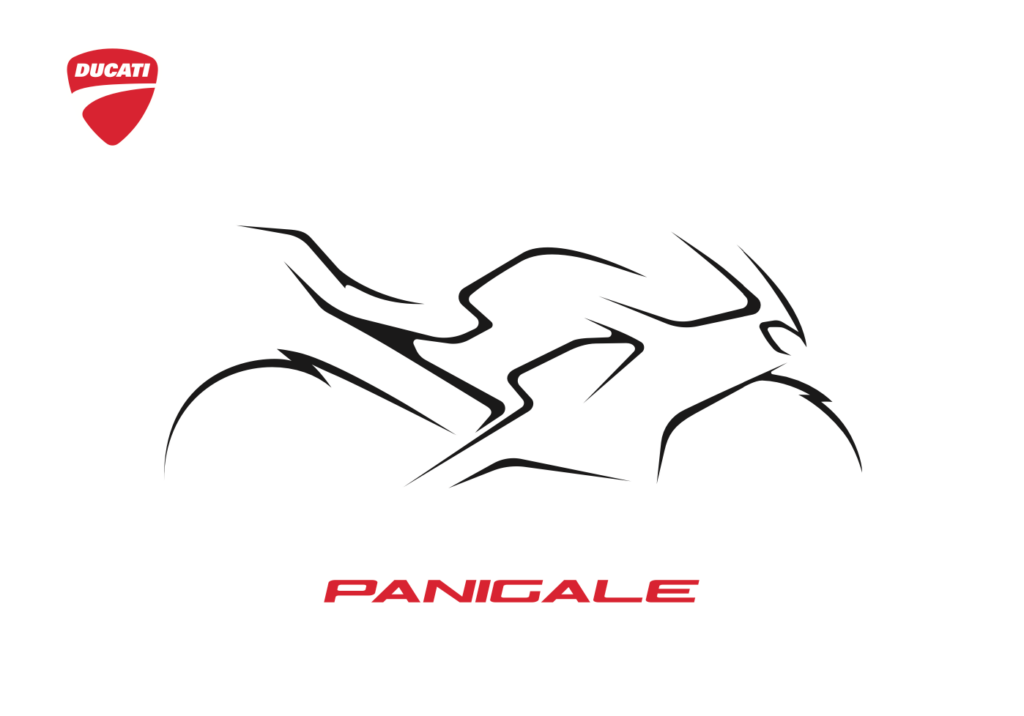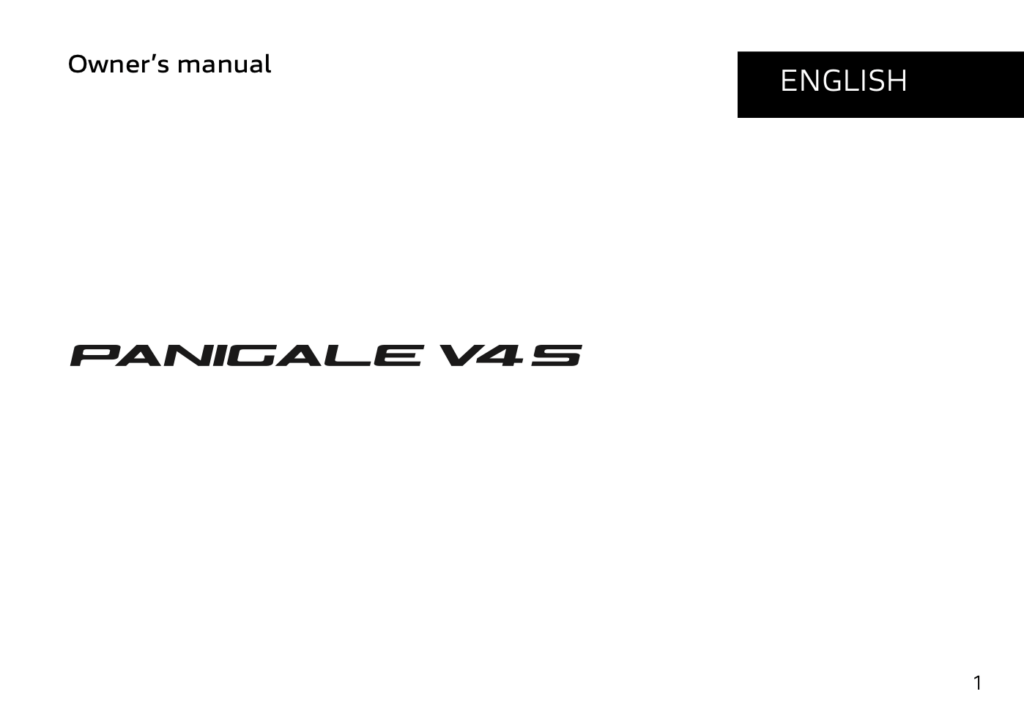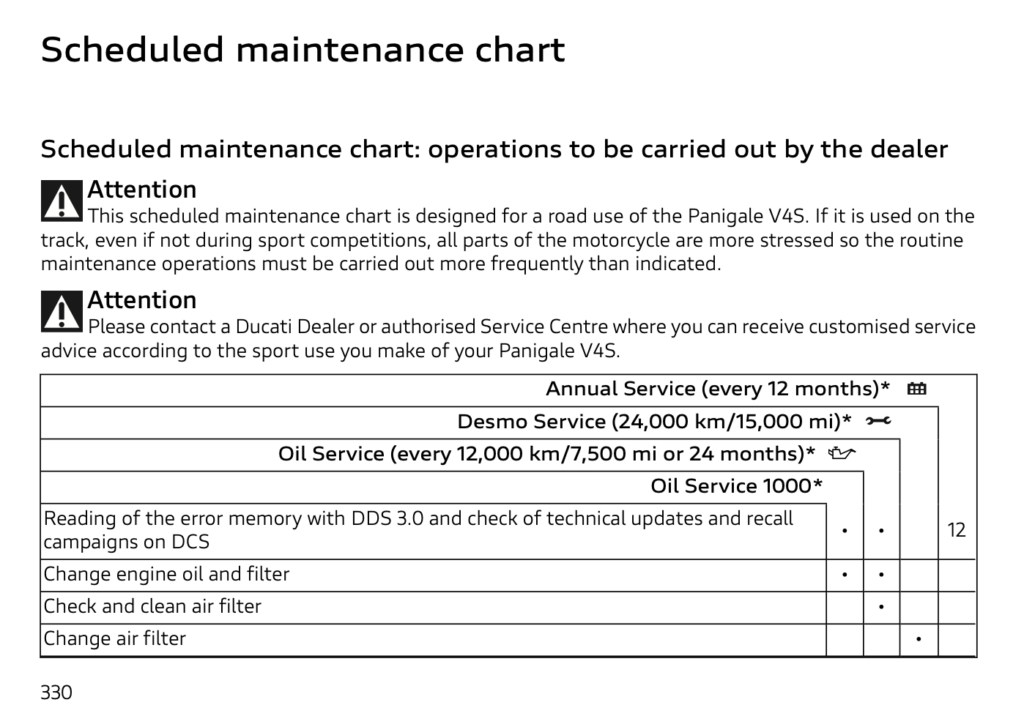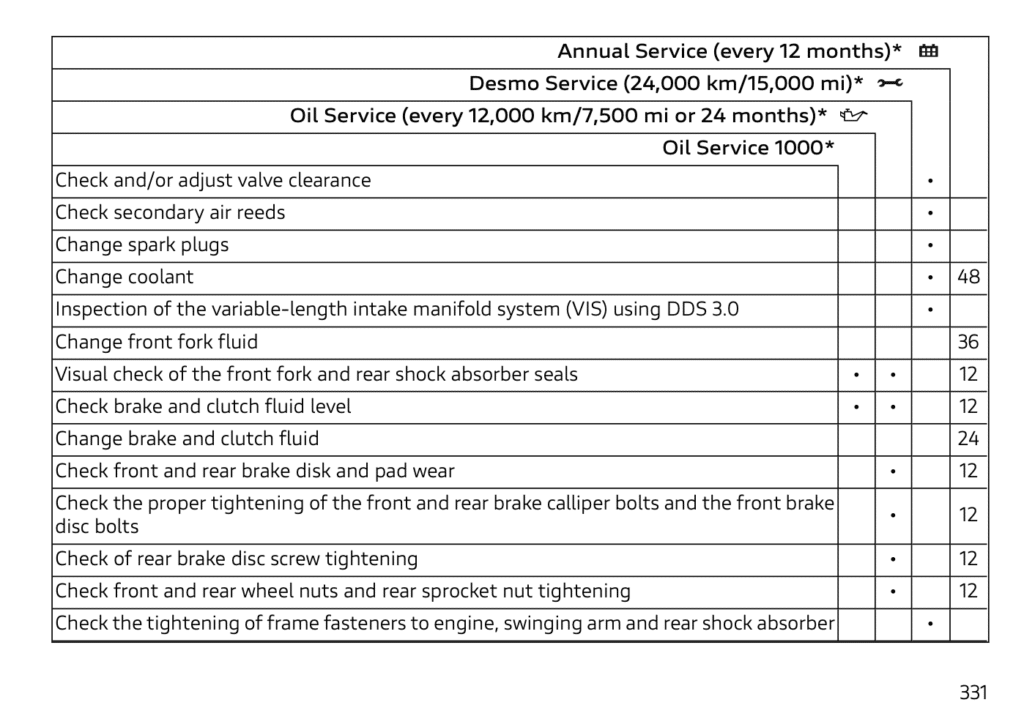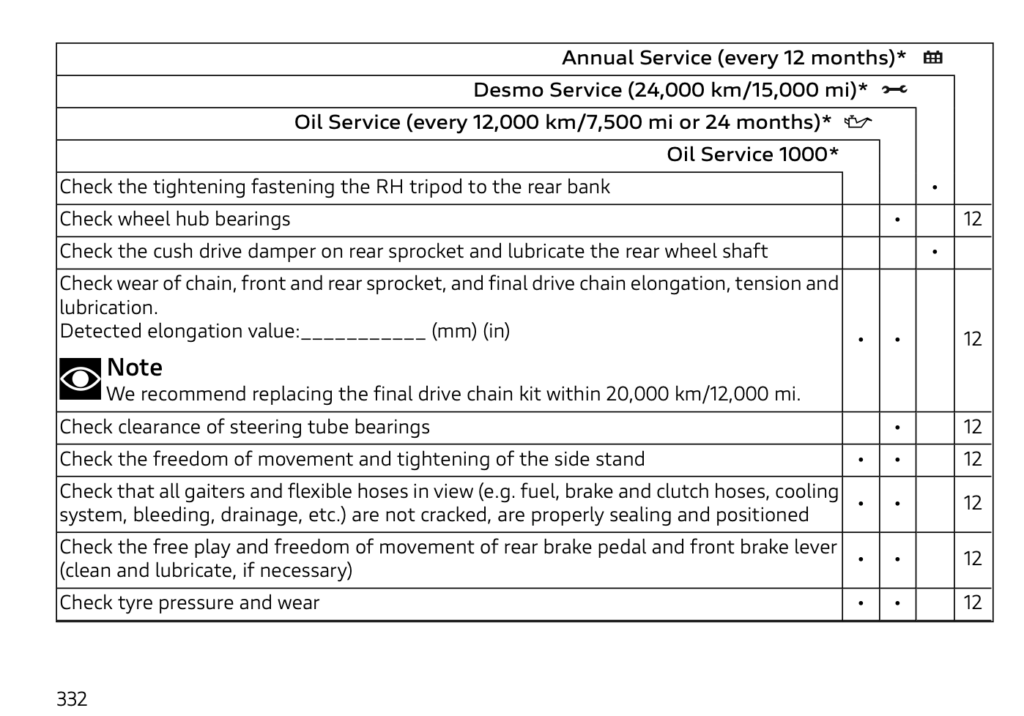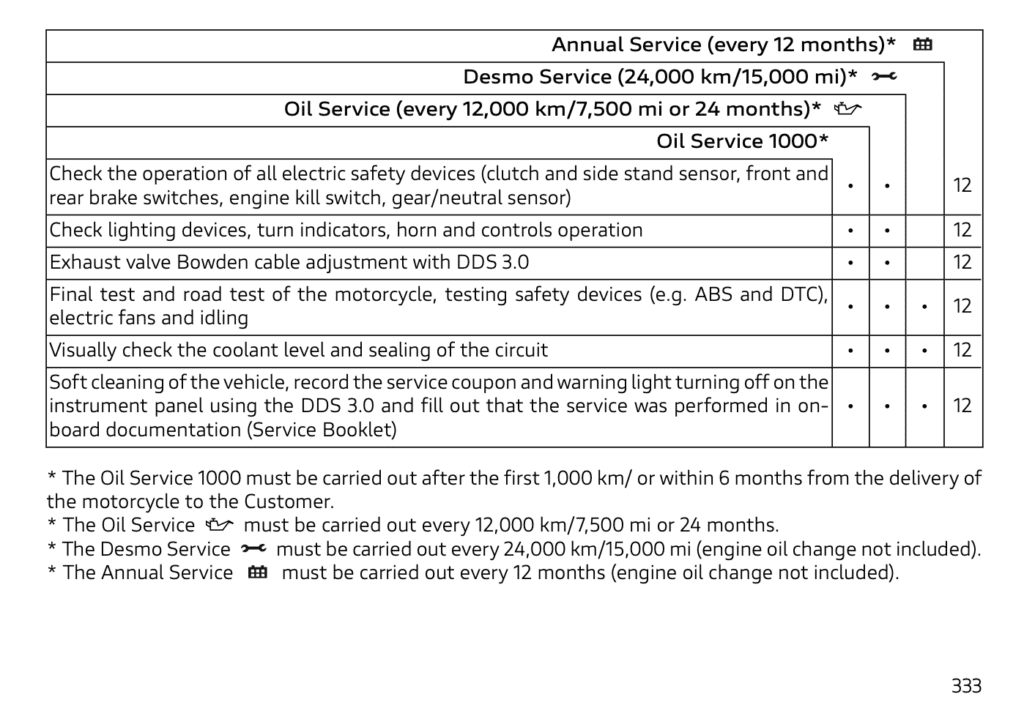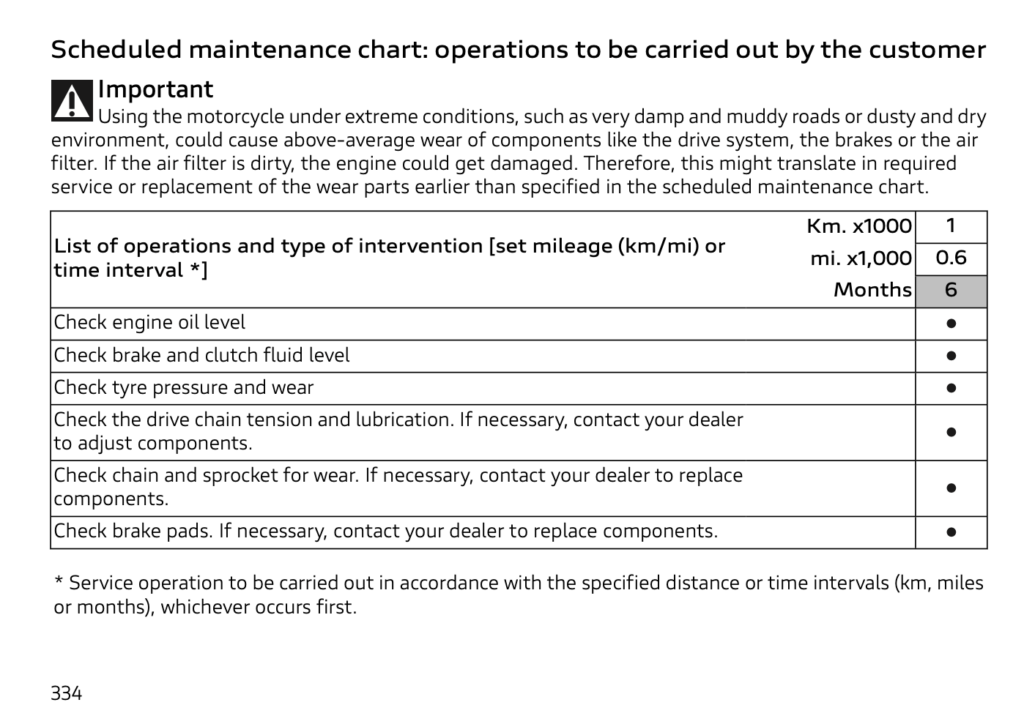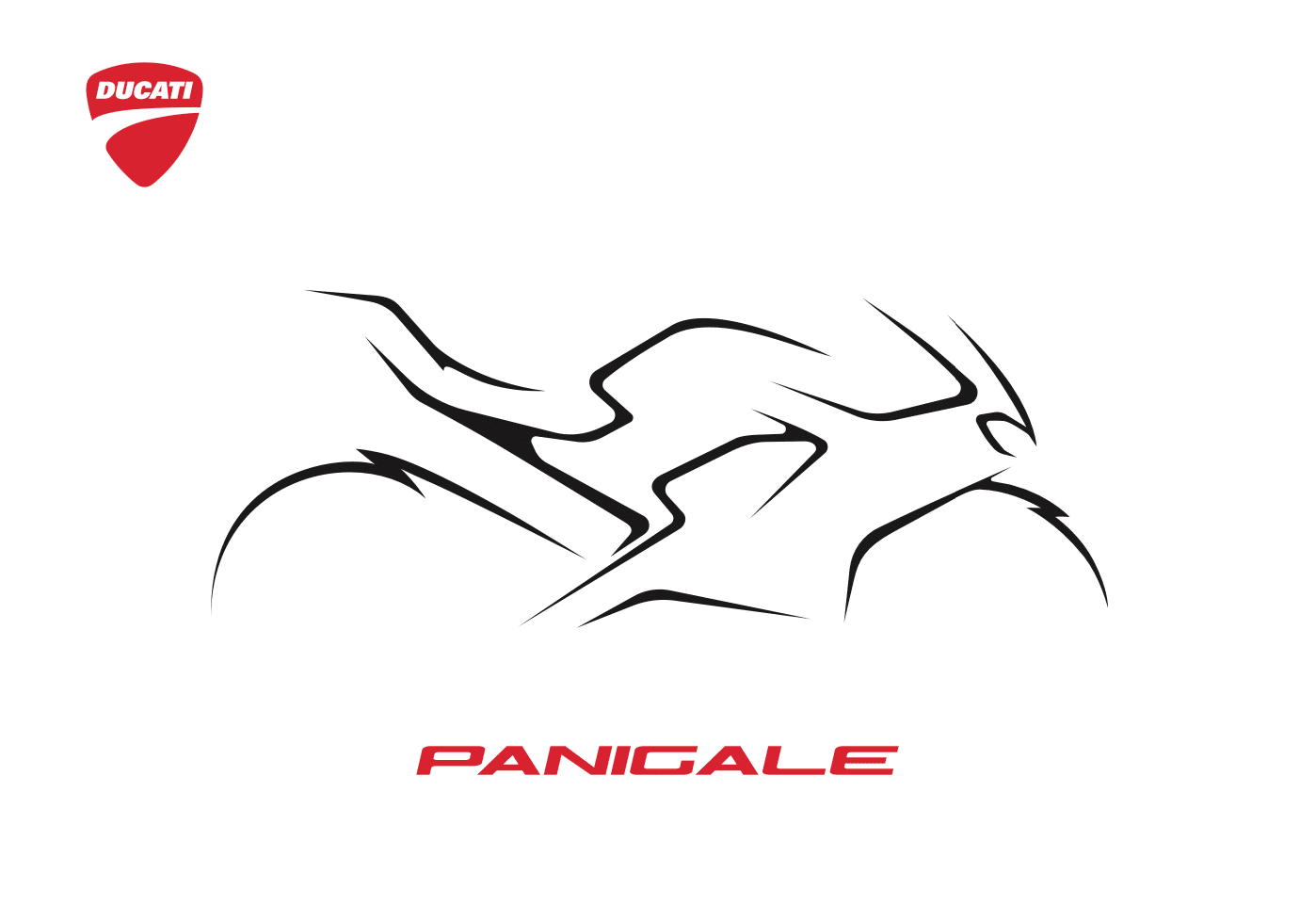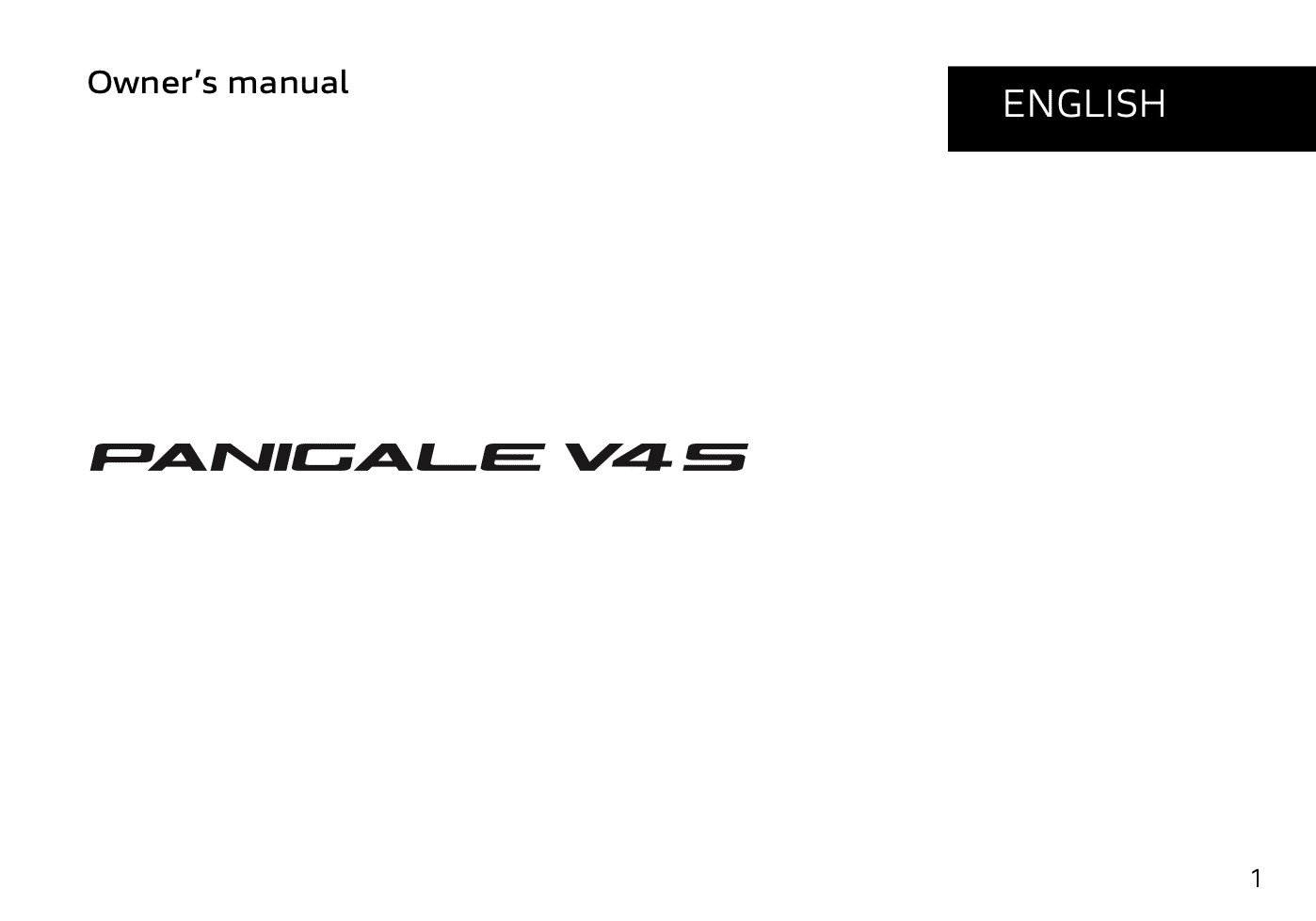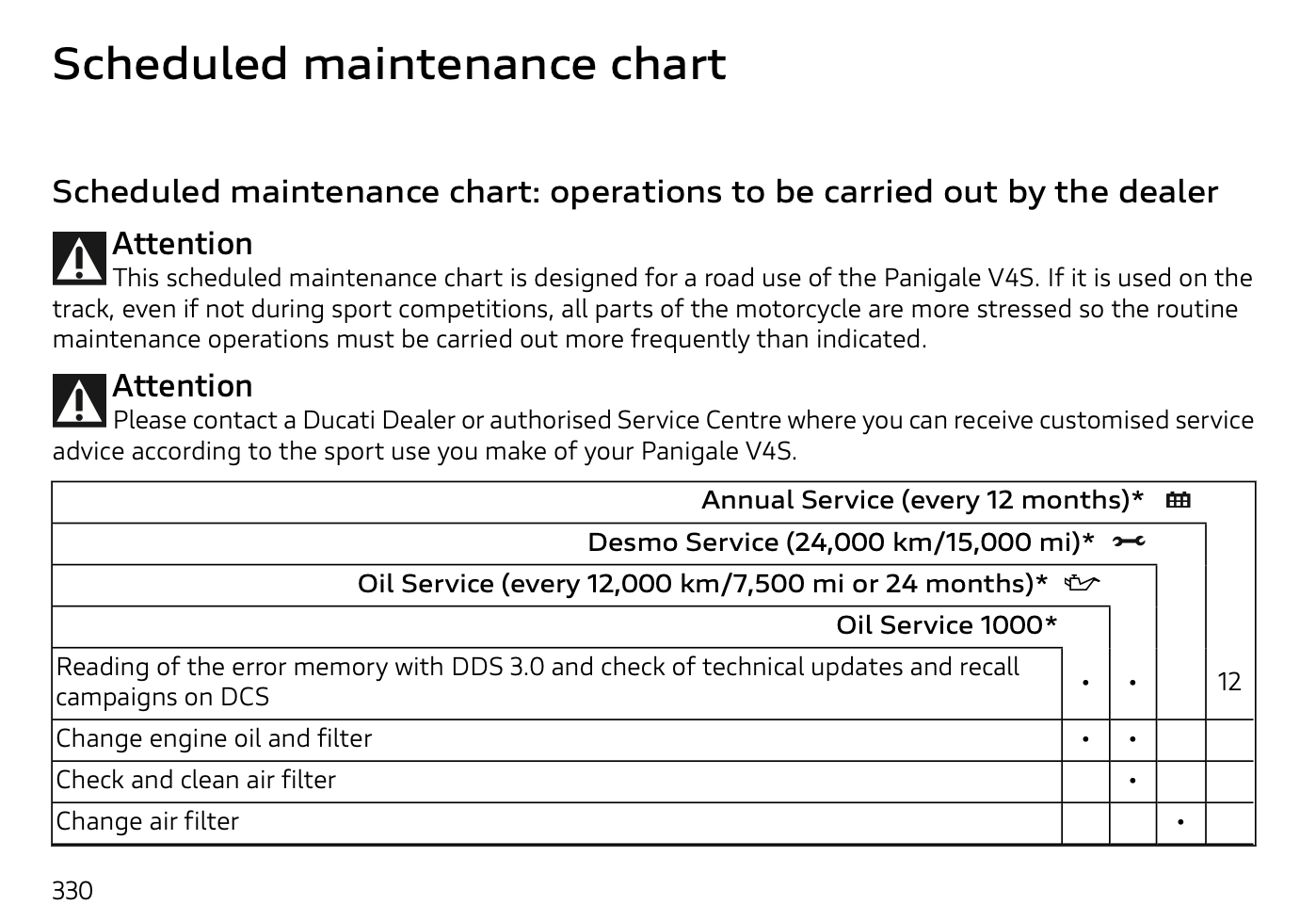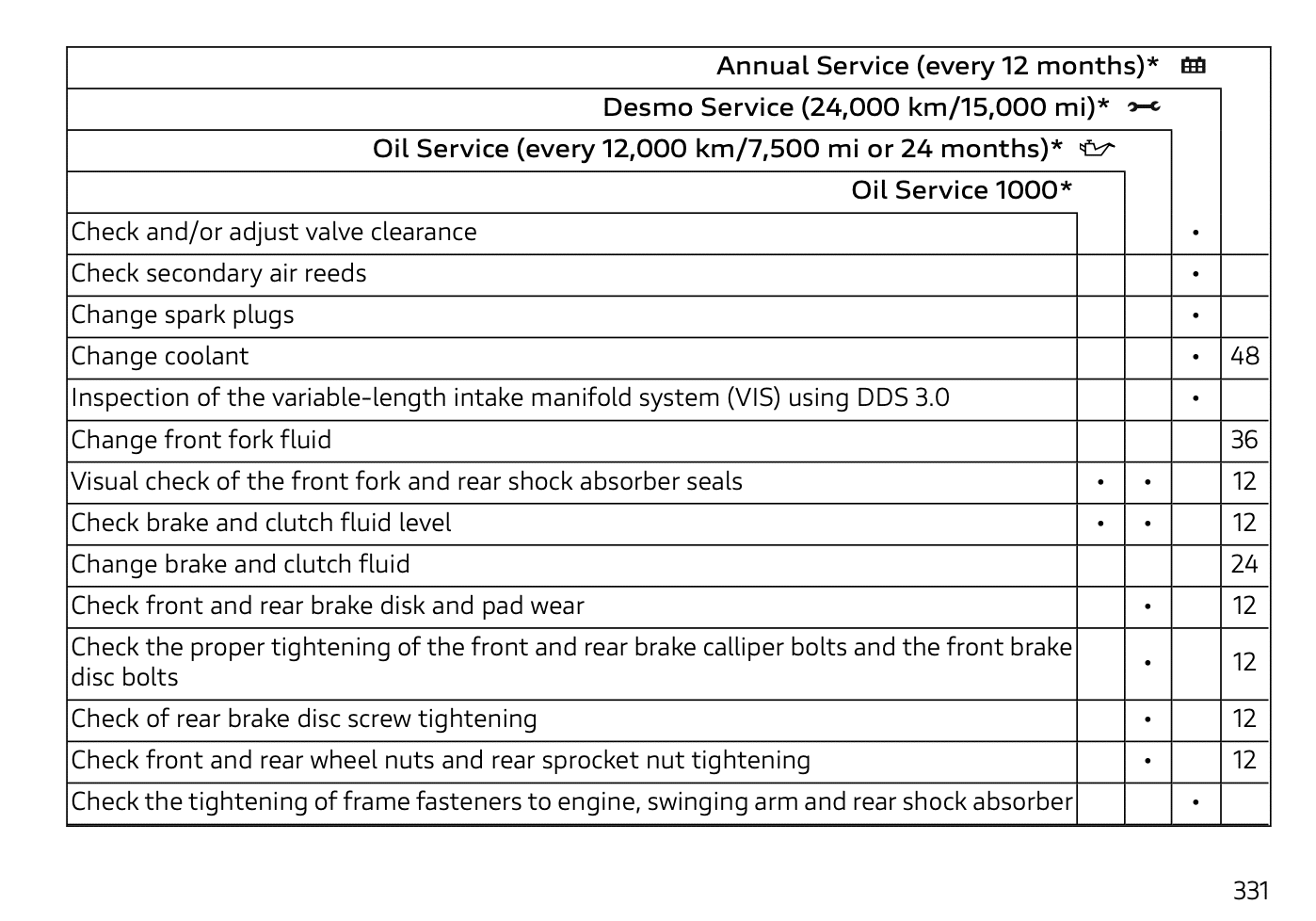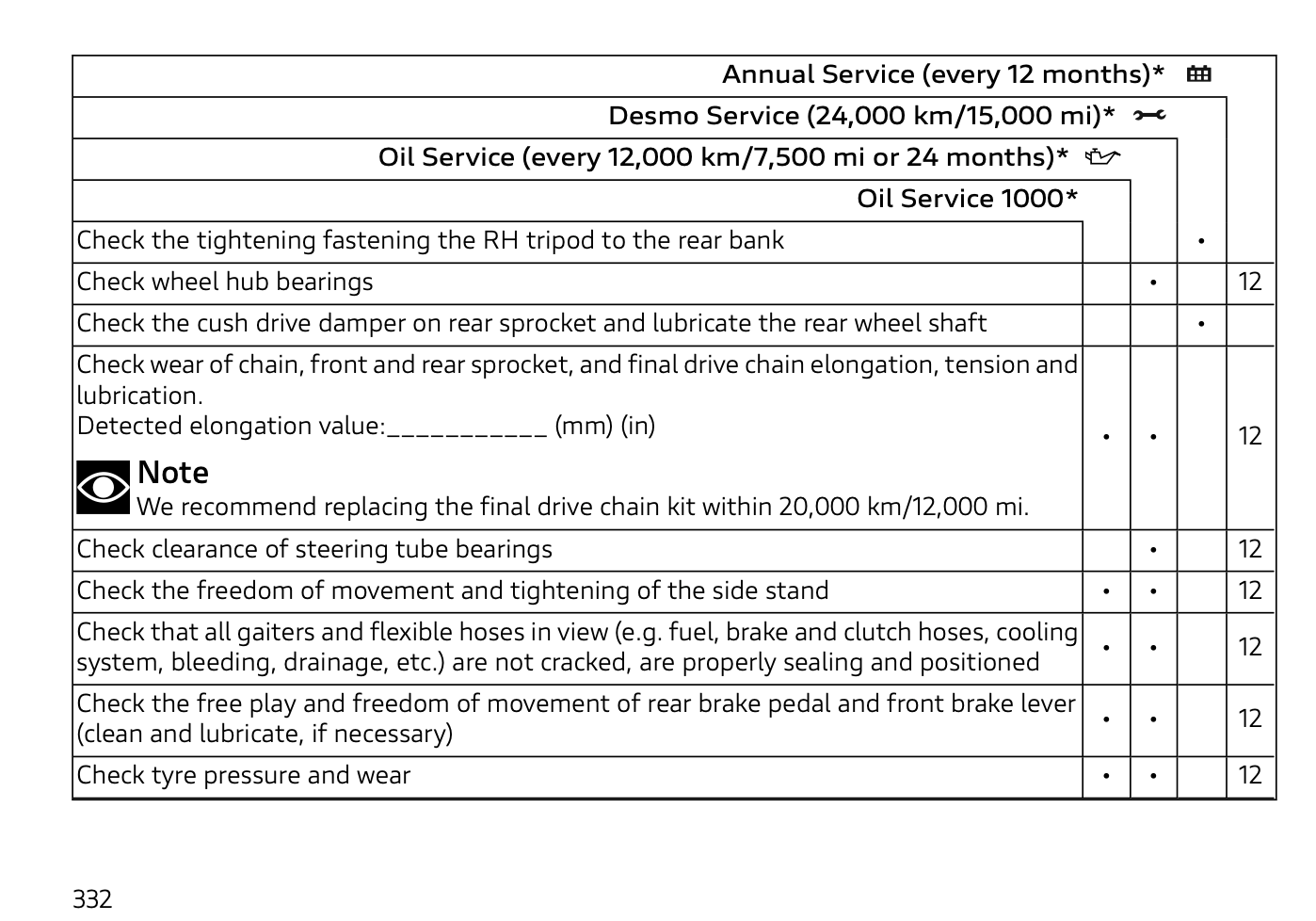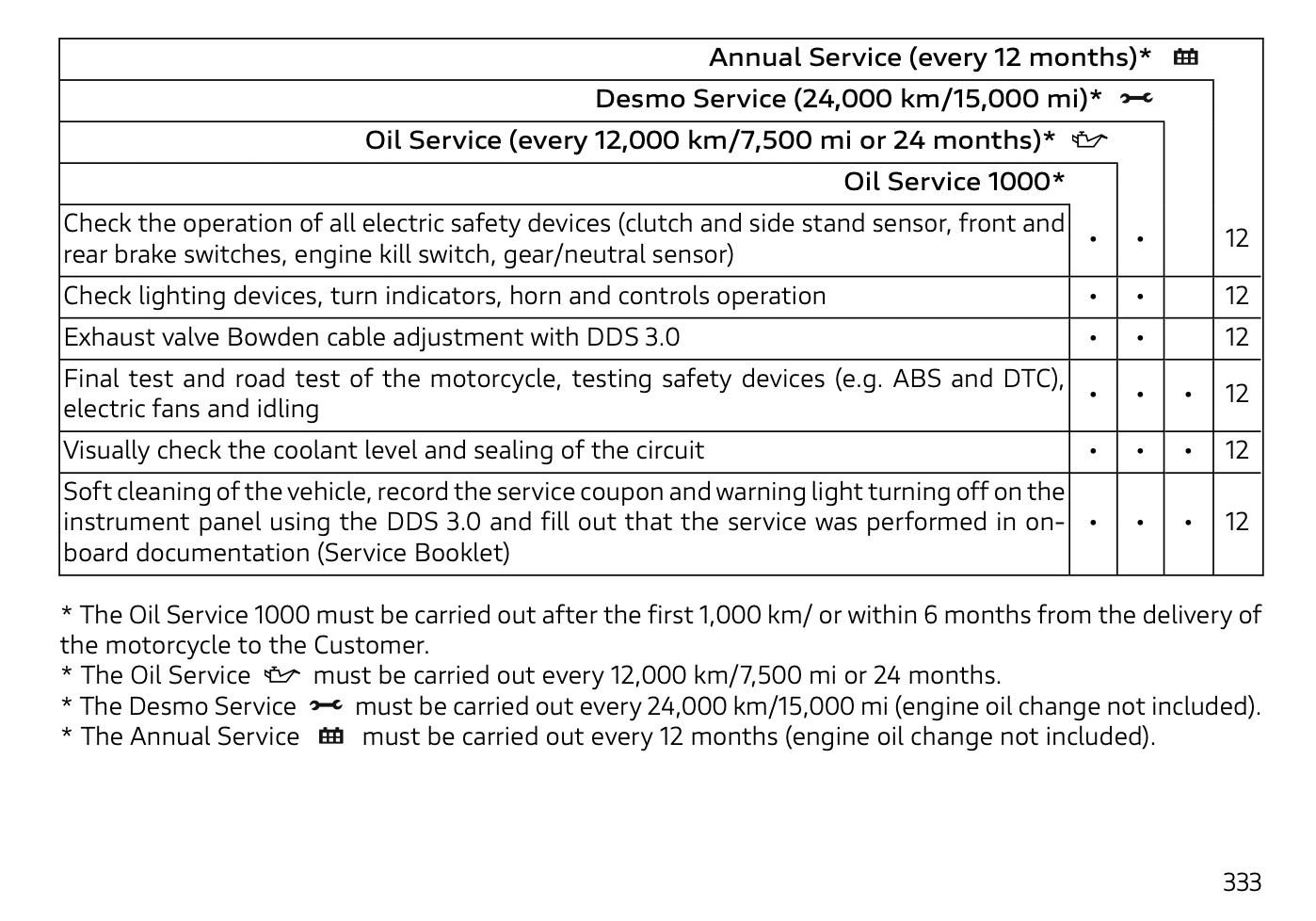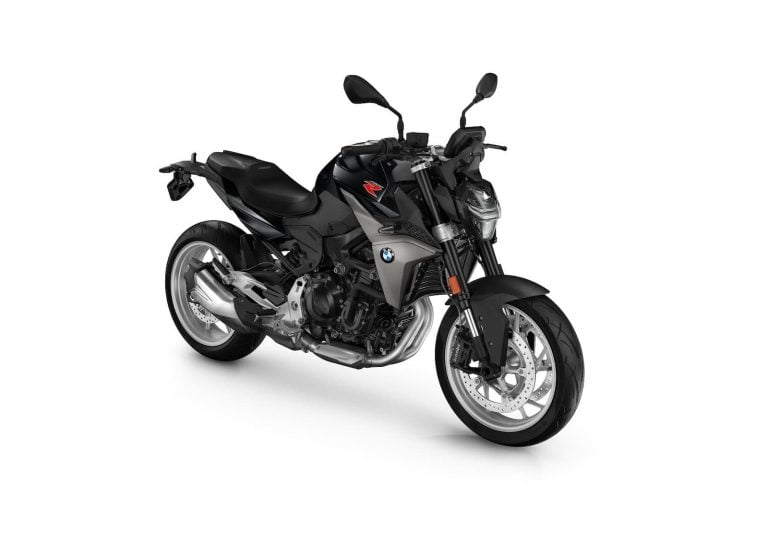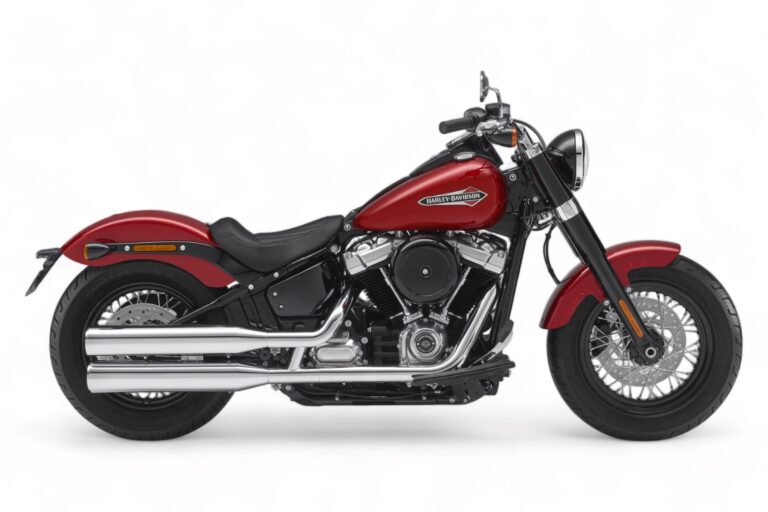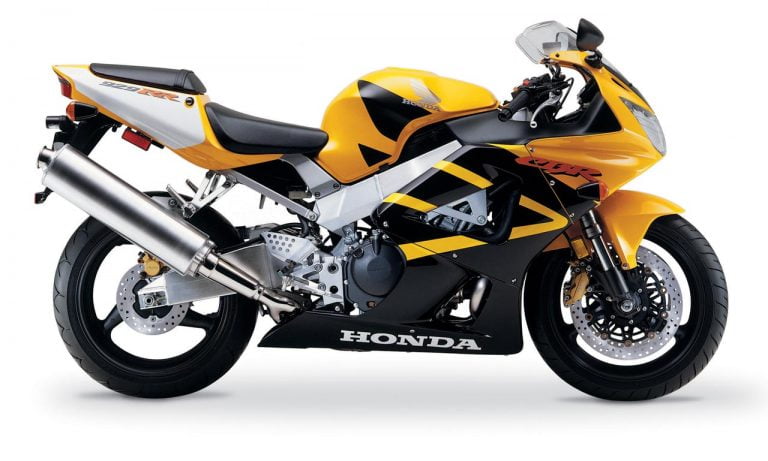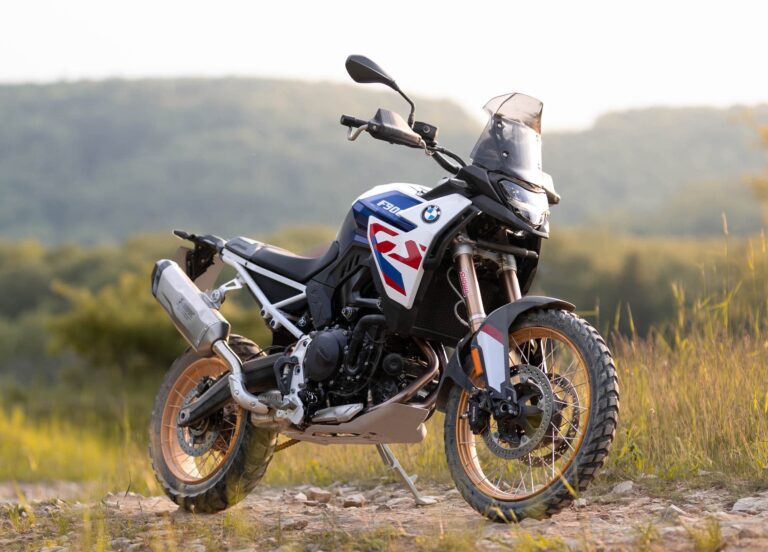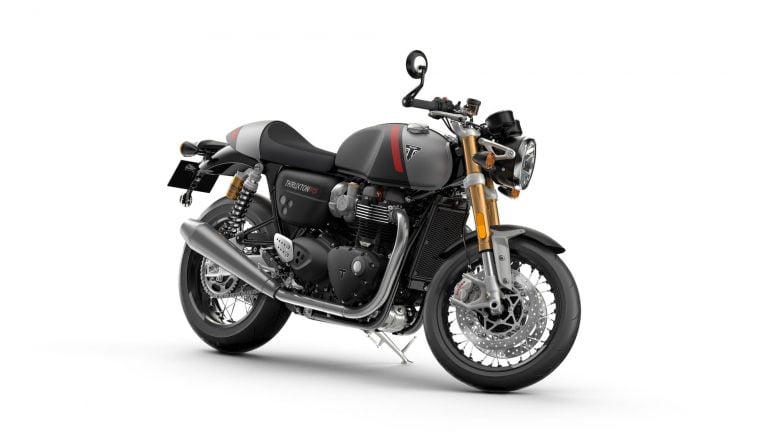Ducati Panigale V4/V4S (2025+) Maintenance Schedule and Service Info
This is the maintenance schedule and service info for the 2025+ Ducati Panigale V4, revised from the previous various revisions of the Panigale V4 with, among other things, a double-sided swingarm. (Sacrilege! But I’m sure they know what they’re doing…)
Fundamentally, the core of the Panigale V4 (and its sibling the V4S) is the same Desmosedici Stradale engine — a 1103 cc liquid-cooled 90-degree V4 with a Desmodromic timing system. Naturally as time evolves, so do emissions specs, so the on-paper power output is slightly different at 158.9 kW / 216 CV (213 bhp) at 13,500 rpm, with peak torque of 120.9 Nm coming at 11,250 rpm. But many owners will fit race exhausts and get custom tunes for track work.
But Ducati made a swathe of updates to the chassis, swingarm (in case you forgot) and the electronics suite, bringing you, the lucky rider, closer than ever to top racer performance.
Aside from the effect on aesthetics, the swingarm changes how you adjust the chain tension. See below for those differences.
This site has links for things like oil and spark plugs from which we earn a commission (which unfortunately nobody can save, not even us). If you appreciate this work, then please use those links. Thanks!
Ducati Panigale V4 Service Intervals
As with the former model, the Ducati Panigale V4’s Desmosedici Stradale motor has minor service intervals of 7500 miles / 12000 km or one year.
Every service, change the oil and filter, and do a comprehensive check of the motorcycle.
The Desmodedici Stradale engine’s valve inspection service interval is 24000 km or 15000 miles, as it was before. It can be an arduous task, as the Panigale V4 has a Desmosedici Stradale engine with 16 valves, each with both an opening and closing cam… so 32 measurements and potential adjustments to make.
Since the Panigale has a hydraulic clutch and brake, you may find it convenient to change brake and clutch fluid at the same time (every 2 years per the schedule).
Further, as the Panigale V4 has a liquid-cooled motor, the coolant needs to be replaced periodically.
One interesting additional part to regular maintenance for the Panigale V4 is replacing the fork fluid, which Ducati recommends every 3 years. This is typical for Ducati bikes.
Finally, keep the chain clean and lubricated.
What you need to service your 2025+ Ducati Panigale V4
Below is the updated list of recommended products and some alternatives for the 2025+ Ducati Panigale V4 models.
| Part | Ducati Panigale V4 spec |
|---|---|
| Engine oil | Ducati recommends “Shell Advance 4T Ultra 15W-50 Fully Synthetic Oil”, or another oil that is the 15W-50, meets API standard SN, and/or JASO standard MA2. Some alternatives are * Mobil 1 15W-50 Full Synthetic * Motul 300V 15W-50 — a commonly mentioned favourite for the V4 |
| Oil filter | The V4 engine uses the same oil filter as many other high-end Ducatis, and you can use a HifloFiltro HF159 as an easy-to-obtain replacement. |
| Spark plugs | Standard spark plugs are NGK LMDR10A-JS, as before (easiest to get from a dealer). |
| Air filter | Ducati part number for the air filter is 42610671A (for prior model; tbc if same as this one). A popular replacement is the K&N air filter with part DU-1118. |
| Brake fluid/ Clutch fluid | Ducati specifies using DOT 4, so use something high quality like Castrol DOT 4 full synthetic. |
| Front brake | Part # for the front brake pad set is 61341271A. You can also use EBC HH brake pads FA447HH. |
| Rear brake | Part # for the rear brake pad set is 61340381A. You can also use EBC HH brake pads FA266HH. |
| Chain management | Ducati doesn’t specify a chain lube, so use something well-liked like Motul chain paste, or maybe clean it with a Motul chain care kit. |
| Coolant | The manual recommends ENI Agip Permanent Spezial antifreeze, or an equivalent. If you track the bike, many prefer Redline Water Wetter and distilled water. |
| Fork fluid | Ducati recommends regularly changing fork fluid, but oddly, doesn’t have a recommendation in the manual for the right fluid. For past models, Ducati has recommended Shell Donax TA fluid for the non-S, and an Öhlins fork fluid for the S. Allegedly Dave Moss recommends 10W fluid in the S (see this thread). |
| Battery | Dead battery? If it hasn’t happened, it will happen. The replacement you need is a Yuasa YT7B-BS (12V – 6.5Ah 10HR) (common to many Ducati motorcycles) |
Regular maintenance for the Ducati Panigale V4
This is maintenance that you can do yourself.
Assuming you ride in everyday conditions (on sealed roads, under “normal” engine stress, every 1000 km/500 miles OR 6 months (whichever comes earlier), perform the following maintenance:
| Panigale V4 — Regular maintenance |
|---|
| Check engine oil level (Motul 300V 15W-50) |
| Check brake fluid level (Castrol DOT 4) |
| Check tyre pressure and wear (see below for recommended pressures) |
| Check the drive chain tension and lubrication (Motul chain paste) |
| Check brake pads and replace if necessary |
Ducati Panigale V4 Maintenance Schedule Table
Below is the maintenance schedule for road use of the Panigale V4. If you use your bike on track, or ride it like you do, all parts of the motorcycle are more stressed so the routine maintenance operations must be carried out more frequently than indicated. You can get customised advice from Ducati about how you intend to use your Panigale V4.
A few notes about maintaining a Ducati Panigale V4:
- The cams are chain driven, which means no belts to replace, unlike bikes based on the Testastretta-11 motor. Hooray!
- As this is a V4 desmosedici motor, there are 16 valves, each with both an opening and closing cam… so 32 measurements and potential adjustments to make.
- Some of the below items can only be done by a Ducati mechanic (marked [D]) as they need Ducati diagnostic equipment or resources.
| km x 1000 | 1 | 12 | 24 | 36 | 48 | Time |
|---|---|---|---|---|---|---|
| mi x 1000 | 0.6 | 7.5 | 15 | 22.5 | 30 | (months) |
| Annual maintenance checklist (see below) — Perform | ✓ | ✓ | ✓ | ✓ | ✓ | 12 |
| Change engine oil (Motul 300V 15W-50) | ✓ | ✓ | ✓ | ✓ | ✓ | 12 |
| Change oil filter (HF159) | ✓ | ✓ | ✓ | ✓ | ✓ | 12 |
| Change engine oil mesh filter assembly | ✓ | ✓ | ||||
| Check and/or adjust valve clearances | ✓ | ✓ | ||||
| Visually check for wear of the chain timing system | ✓ | ✓ | ||||
| Visually check the wear of the oil pump drive chain | ✓ | |||||
| Change spark plugs (LMDR10A-JS) | ✓ | ✓ | ||||
| Clean air filter | ✓ | ✓ | 12 | |||
| Change air filter (DU-1118) | ✓ | ✓ | ||||
| Change brake and clutch fluid (Castrol DOT 4) | 24 | |||||
| Check and lubricate the rear wheel shaft | ✓ | ✓ | 24 | |||
| Check steering bearings and lubricate, if necessary | ✓ | ✓ | ||||
| Change front fork fluid (Shell Donax TA) | 36 | |||||
| Change coolant (ENI Agip Spezial) | ✓ | 48 | ||||
| Replace the fastening screws of clutch cover, clutch protection cover, generator cover, and oil sump | ✓ | ✓ | ||||
| Check front and rear wheel hub bearings | ✓ | ✓ | ||||
| Check the cush drive damper on rear sprocket | ✓ | ✓ | ||||
| Visually check the fuel lines | ✓ | ✓ | ||||
| Check secondary air system operation | ✓ | ✓ | ||||
| [D] Reset the variable-length intake manifold system (VIS) using DDS 2.0 | ✓ | ✓ | ||||
| [D] Adjust the Bowden cable of the exhaust valve opening through the DDS 2.0 | ✓ | ✓ | ✓ | ✓ | ✓ |
Annual maintenance checklist
Below is the annual maintenance checklist for the Ducati Panigale V4. Perform it according to the schedule above.
| Ducati Panigale V4 annual maintenance checklist |
|---|
| [D] Read the error memory with DDS 3.0 and check software version update on control units |
| [D] Check the presence of any technical updates and recall campaigns |
| Check brake and clutch fluid level Fluid level drops with wear of the brake and clutch. Top up with Castrol DOT 4 or similar |
| Check brake pads. Change if necessary |
| Check the proper tightening of brake calliper bolts and brake disk flange screws |
| Check front and rear wheel nuts tightening |
| Check the proper tightening of final drive front and rear sprocket nuts |
| Check final drive chain tension and lubrication (Motul chain care kit) |
| Check final drive chain sliders for wear |
| Visually check the front fork and rear shock absorber seals |
| Check for proper tightening of the frame-to-engine fasteners and swinging arm |
| Check the freedom of movement and tightening of the side stand |
| Check rubbing points, clearance, freedom of movement and positioning of hoses and electric wiring in view |
| Lubricate the levers at the handlebar and pedal controls (Lithium soap-based grease) |
| Visually check the coolant level and sealing of the circuit |
| Check electric fan operation |
| Check tyre pressure and wear (See below for standard tire pressures) |
| Check idling |
| Check the battery charge level |
| Check the operation of all electric safety devices (side stand sensor, front and rear brake switches, engine kill switch, gear/neutral sensor) |
| Check lighting devices, turn indicators, horn and controls operation |
| [D] Reset the Service indication through the DDS 3.0 |
| Final test and road test the motorcycle, testing safety devices (e.g. ABS and DTC) |
| Softly clean the motorcycle |
| [D] Fill out that the service was performed in on-board documentation (Service Booklet) |
Ducati Panigale V4 Chain Maintenance
Ducati recommends cleaning and lubricating the chain regularly — every 1000 km / 600 miles or 6 months, or earlier if you ride in adverse conditions. Ducati recommends Shell Advance chain lubricant, but you can use any high-spec chain lube, like Motul chain lubricant for example.
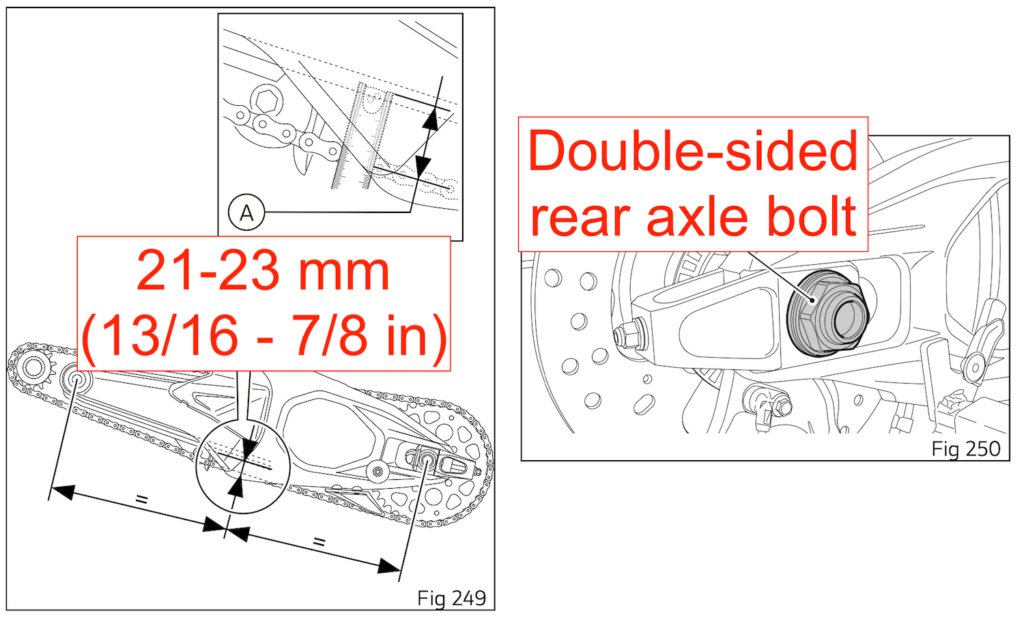
Aside from lubing and cleaning the chain, you should check the chain slack.
To check the chain slack on the Panigale V4, measure the distance between the chain and the sliding guard (not just the free vertical movement).
- Find the point where the chain is tightest (rolling it around)
- Put the motorcycle on its side stand.
- Push the finger down with a finger and release it.
- Measure the distance between the centre of the chain pins and the chain sliding guard.
Target chain slack for the Ducati Panigale V4 (2025+): 21-23 mm (13/16-7/8 inches) (Note, this is slightly different from the previous generation)
Ducati doesn’t give guidance on how to adjust the chain tension, but given it’s a double-sided swingarm, the procedure is likely to be the same as on most conventional motorcycles. However, they don’t provide torque specs for tightening the rear axle bolt, or guidelines for maintaining chain alignment.
It’s worth noting the pros and cons of a single sided swingarm when it comes to chain maintenance.
| Swingarm type | Pros | Cons |
|---|---|---|
| Single-sided | * Looks great! * No worrying about chain / wheel alignment when removing wheel or adjusting tension * Easy to change tension but may need special tools (e.g. C-spanner) | * Much higher torque needed to tighten rear wheel * Special tools may be needed to change chain tension * Needs a special rear stand (or a steel rod and a normal stand for a cheap hack) |
| Double-sided | * Can use any double-sided swingarm rear stand * Lower torque needed to tighten rear wheel * Don’t need special tools | * Have to worry about chain alignment when adjusting tension or changing wheel/tyre * Doesn’t look as cool |
Since you often have to adjust the chain tension on chain-driven motorcycles, not having to because you have a single-sided swingarm is a minor blessing.
Tyre sizes and pressures for the Ducati Panigale V4 (2025+)
The manual says that the Panigale V4 arrives shod with Pirelli Diablo Supercorsa SP-V4 “tubeless” tyres.
Here are the tire sizes and recommended pressures.
| Wheel | Rim size | Tyre size | Tyre pressure (cold, single rider) |
|---|---|---|---|
| Front | MT3.50 x 17 | 120/70-ZR17 | Road: 2.1-2.3 bar (30.5-33.4 psi) On track: 1.8-2.3 bar (26.1-33.4 psi) |
| Rear | MT6.00 x 17 | 200/60-ZR17 | Road: 2.1-2.3 bar (30.5-33.4 psi) On track: 1.8-2.3 bar (26.1-33.4 psi) |
Note that Ducati recommends the same tyre pressures front and rear.
The manual also has suggested tyre pressures for if you have a pillion and even bags. But that isn’t a common use case. I’d suggest you find your own ideal pressure in that (somewhat unusual and thus very variable) situation.
About the Ducati Panigale V4 (2025+)
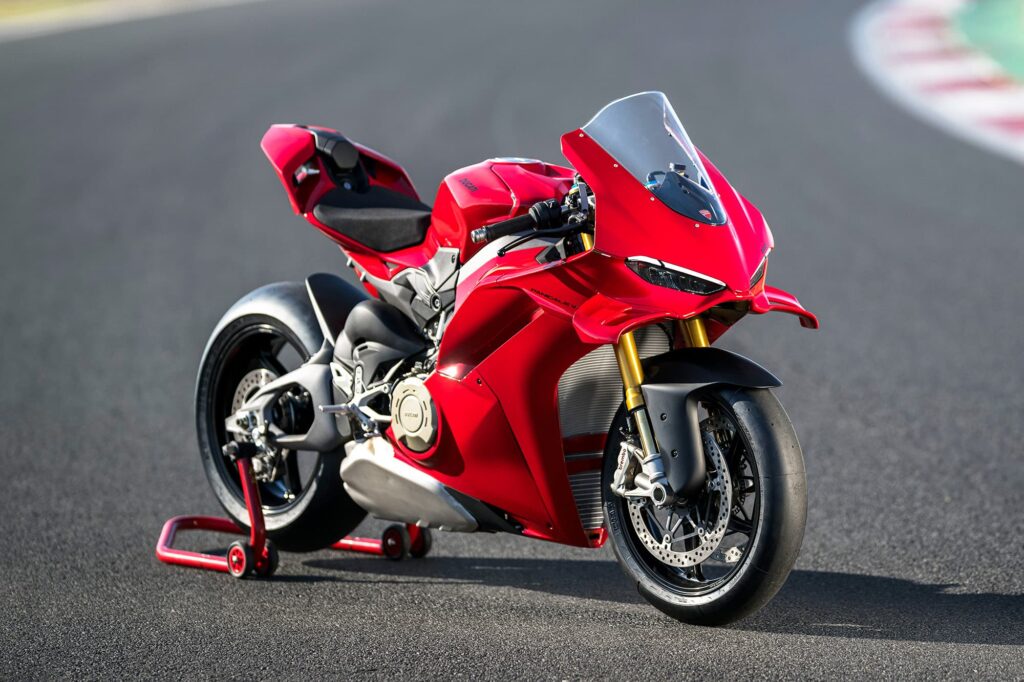
Since its first launch in 2018, the Ducati Panigale V4 has been one of the “it” bikes of the motorcycling world. Whether you’re a track day nut, an everyday rider, or someone who just wants to park one in their living room and admire it, riding it just once a year, the Panigale has it all — power, handling, looks, and even status, if that’s your jam.
Before the Panigale V4, the idea of four cylinders was anathema to most Ducatisti. But now, with Ducati having released another V4 engine (the V4 Granturismo, seen first in the Multistrada V4) and even another single-cylinder engine, it’s safe to say people are used to the concept of something other than V-twins.
The core of the new-for-2025 Panigale V4 is the same Desmosedici Stradale engine, its name a reference to the 16 valves (“sedici” means “sixteen” in Italian), and a callback to the stomping engine in the Desmosedici RR GP bikes.
Thus, maintenance of the engine is the same as before. Ducati hasn’t made any significant changes to the maintenance for the engine specifically, only mentioning that you should use DDS 3.0 now rather than DDS2.0 which was the latest at the time of release of the original V4, and that there are different chain maintenance requirements given the double-sided swingarm.
The engine is a classic and an engineering marvel. It has a counter-rotating shaft and twin-pulse timing, which contribute to making it much easier to turn in and giving it a sound like a Desmosedici GP bike — even in base trim.
Ducati did make some changes to the engine, though — so the parts are different. There are different camshafts (with a different profile and higher lift), a high-spec alternator and oil pump that came from the V4 R, and the lightweight gearbox drum from the Superleggera V4.
The swingarm is called the Ducati Hollow Symmetrical Swingarm. Ducati designed it to be strong and lightweight and to keep the position of the silencer under the engine for mass centralisation and low mass overall. The combined weight reduction of the swingarm and forged rim on the V4S is 2.7 kg or 6 lbs — leading to much better contact for putting power to the ground.
Ducati also lightened the frame (the Front Frame is 3.47 kg vs the earlier 4.2).
So what changed, aside from the engine internals and the swingarm? Quite a lot.
Firstly, the new Panigale V4S weighs 2 kg (4.4 lb) less than the previous model. Every kilo or pound counts! Curb weight without fuel is 187 kg or 412 lb. The base model is heavier at 191 kg.
Secondly, Ducati made some aerodynamic improvements, claiming to reduce resistance by 4%. They achieved this through high-efficiency wings and changing the shape of the fairing and mudguard.
In terms of differences between the new V4 and V4S, the V4S gets electronic Öhlins suspension, lighter wheels, and a lithium-ion battery. But aside from that, the engine and other base components and all tech is the same.
| Model | 2025 Panigale V4 base model | 2025 Panigale V4S |
|---|---|---|
| Front suspension | Fully adjustable Showa BPF fork Ø 43 mm chromed inner tubes | Öhlins NPX 25/30 pressurized fork with TiN treatment, fully adjustable with electronic compression and rebound damping adjustment via Öhlins Smart EC 3.0 event-based mode |
| Rear suspension | Fully adjustable Sachs unit with Aluminum Hollow Symmetrical Swingarm | Fully adjustable Öhlins TTX36 unit with electronic compression and rebound damping adjustment via Öhlins Smart EC 3.0 event-based mode |
| Wheels | Light alloy | Forged aluminium alloy |
| Battery | Standard | Linium-ion |
Thirdly, Ducati has upped the spec from Brembo Stylema calipers to Brembo HypureTM calipers. These are both lighter and higher performing. Stylema are almost commoditised now, with mid-spec bikes like the CFMOTO 700 CL-X Sport getting it (in some markets), even though they’re objectively wonderful!
Fourthly, Ducati updated the electronics, totally revising the new dashboard, and adding a “Vehicle Observer” innovation.
All those details make incremental improvements that gives the 2025 Panigale V4 and V4S just slightly better performance than the outgoing model. But many will stick around for the single sided swingarm alone.
References — Screenshots from the 2025 Ducati Panigale V4 Owner’s Manual
The above info was sourced from the owner’s manual for the 2025 Ducati Panigale V4S. It covers everything that is necessary for the base model V4 too.
You can download it from the Ducati website here.
